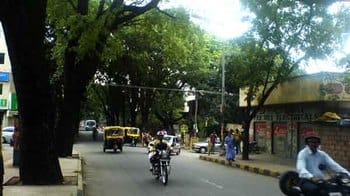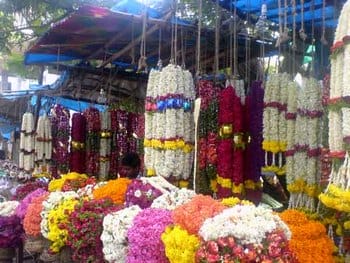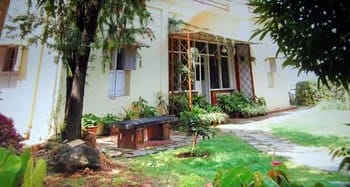It was the year 1848. Krishnaraja Wodeyar IV was the Maharaja of Mysore. A plague epidemic had hit Bangalore. Perturbed by living conditions in the cramped city area (primarily in and around present day Majestic), the forward-looking Dewan of Mysore, Sheshadri Iyer, initiated the creation of Malleswaram and Basavanagudi. His vision was to create new and clean suburbs to accommodate the city’s burgeoning population.

A view of Margosa Road. Pic: Author.
I remember going to Malleswaram as a kid tagging along with my mother for shopping sprees. A lot of memories come flooding back – the Malleswaram Circle Jataka (Tonga/horse cart) Stand smelling of hay, piping hot dosas at 8th Cross Janatha Hotel and of course the shopping. The Malleswaram I remembered was full of shops, trees, temples and outstanding South Indian food.
In a city growing as rapidly as Bangalore is, how much had Malleswaram changed? Had the glass-and-chrome-building brigade invaded this area? Were the temples intact? Had the mega mall replaced the corner angadi (store)? I set out on a cloudy morning to find out.

Kadu Malleswara Temple. Pic: Author.
As I walked down the ‘Temple Street’, a narrow one lane road, a young boy zipped past me in his shiny new bike. Glaring at him and with not so holy thoughts in my mind, I entered the religious zone. Kadu in Kannada means forest. This area was once a thickly wooded region and the Kadu Malleswara temple dates back to the time of Maratha ruler Shivaji whose brother Venkoji constructed this temple.
The Nandeeshwara Temple situated opposite to this has a more fascinating story. This ancient temple was apparently buried under thick layers of soil. According to the priest, when a local politician tried to sell this place a few years back, the people from the neighbourhood opposed the move and demanded an excavation. To their amazement, this underground temple and the kalyani (tank) was intact, complete with water pouring out of a Nandi statue’s mouth onto a Shiva linga (idol) directly below it.
I sat watching the serene Nandi for sometime, admiring the sculptor’s ingenuity and pondering over the temple’s unknown history. Adjacent to Kadu Malleswara stands yet another old temple, the Lakshmi Narasimhaswamy temple, built in Dravidian style with the traditional gopuram. I would recommend sitting under the tree in the temple courtyard as a wonderful therapeutic experience.
On the corner of this street is Adigas, a South Indian Fast Food joint, creating wafting aromas that beckon you. Few yards away from these centuries-old temples stands a modern day glass and chrome building that houses ‘Coffee Day’ and ‘Health and Glow’ outlets.
Diagonally opposite this stands a dilapidated house complete with chicken-mesh windows and rounded balconies. Next to this old building an Airtel outlet exists peacefully. You see this old-and-new juxtaposition everywhere in Malleswaram.

Halli Mane. Pic: Author.
Malleswaram has been planned like a chess board. Roads running from North to South are Main Roads and perpendicular to these are Crosses. There is also a Boundary Road that, true to name, runs beside the Railway line to mark the boundary to this ‘extension’. Any Malleswaram landmark or address will consist of a Cross and a Main. The two major cross roads are 8th cross and 18th Cross. Between these cross roads run two Main roads. The wonderfully named Sampige and Margosa Roads derive their names from the flowery Sampige and Margosa trees that once lined these roads.
8th Cross could be termed as the middle class version of Brigade Road. However, far from the western look of Brigade Road in the city centre, 8th cross has a typical South Indian feel. The Ganesha Temple, the teeming vegetable markets, numerous textile shops and street vendors creates a melange of colourful chaos. The mound of kumkum and haldi in the grandhige angadi is a sight for sore eyes.
Make it a point to walk through the adjoining 11th Cross market and inhale the fragrance of the world’s best perfume – fresh flowers and garlands. On the eve of a festival, this place is abuzz like a beehive.

Flower Stall at 11th Cross Market. Pic: Author.
Though there are many small retail shops, it’s the street vendors who add the special charm to this place. These vendors sell pretty much everything under the sun, from baskets to bindis, and handbags to clothes. I wanted to take a photograph of some rangoli designs made by a boy selling sieves that creates readymade rangoli patterns. He was slightly awed by the fact that what he was doing merits a photograph.
A flower seller nearby complained, ‘Madam, neevu photo tagondu paper ge haktira, illi Police bandu namanna odistare’ (‘Madam, you publish our photos in the newspaper and the police shoo us away’). Mr Shankar Prasad, a resident of the area for over 50 years, remarked that there is always a cat and mouse game between the street vendors and the police. His solution – convert 8th Cross into a non-motoring zone and let all the vendors and shoppers conduct their business peacefully.
Malleswaram has many fantastic eateries serving affordable and absolutely yummy South Indian fare. CTR (now unimaginatively called Shree Sagar), Janatha Hotel, idlis at Veena Stores, Eat Out Circle, akki roti at Halli Mane, badam milk at Asha Sweets, take your pick. Mr. Ananthram, who lived in Chandigarh for 30 years, vouches for Shakthi Restaurant for its authentic North Indian food. Shopping could just be an excuse to tuck in.

Shankar Prasad’s 90- year-old residence. Pic: Author.
Chowdiah Hall on 16th Cross is the venue for innumerable music and theatre events. Sankey Tank, a soothing water body, is just across the road and is perfect for an evening walk.
The verdant Indian Institute of Science campus provides much-needed lung space. This Institute was the brainchild of Jamshedji Tata. In 1898, the Royal Society of London conducted a survey and found Bangalore as the most suitable location for such an Institute. It has become India’s premier science research institute and many eminent scientists like Sir C V Raman, Homi Bhabha, Vikram Sarabhai and CNR Rao have been associated with it.
Malleswaram is also home to many famous institutions such as MES (Mysore Education Society), B P Indian School and Cluny Convent. One of the founders of MES Institution, M Chinnaswamy, also founded KSCA and the cricket stadium is named after him.
Malleswaram at a Glance
Things to do
Temple Tour
Kadu Malleswara, Lakshmi Narasimhaswamy, Nandeeshwara – 15th Cross
Kannika Parameshwari – 8th Cross
Ganesha – 8th Cross
Venu Gopalaswamy – 11th Cross
Sri Sai Mandali – Sampige Road
Raghavendra Swamy Math – 8th Cross
More
Theatre at Chowdiah Hall, Boat Rides at Sankey Tank
Eat Out
Halli Mane- 4th Cross Malleswaram
Benne Gulkhand – Sampige Road, near Malleswaram Circle
Sai Shakthi – 4th Main, 8th Cross
Central Tiffin Room (CTR) – 7th Cross
Janatha Hotel – 8th Cross
Asha Sweets – Sampige Road
Veena Stores – 16th Cross
Eat-Out – 15th Cross, near MES College
Adigas – 15th Cross & Sampige Road
Shopping
Chandni Silks (formerly Poornima Silks and Sarees) – 11th cross
Rangachari Silks – Malleswaram Milk Corner
Iyengar Jewellers – 11th cross
Mahendra Vastralaya – 8th cross
Mummy Daddy, Veenus – kidswear on 8th cross
Just go shopping here and you’ll find many more.
Important Personalities from Malleswaram:-
Cricket Administrator – M. Chinnaswamy
Scientists – CV Raman, CNR Rao
Musician – Veena Doraiswamy Iyengar
Dance Guru – Keshava Iyer
Dewan – Sheshadri Iyer
Acadamecian – M P L Shastry
Poet – G P Rajaratnam
One of Malleswaram’s most famous residents was Sir C V Raman. His house still stands next to the MES College, his family not yet tempted by the soaring realty prices to sell out. Mr Prasad’s 90 year old house, however, is now being replaced by a new apartment complex. Though they are nostalgic about the place, his wife, Usha, commented that they had to be practical. The house was crumbling and maintenance cost was high.
Change, sadly, is inevitable. Villa Polipatti (maintained as a heritage hotel) or the elegant building on 6th Main that houses the Information and Broadcasting Department still stand proudly, reminding us of another era. In this rapidly changing world, Malleswaram has managed to retain a fine balance between its old charm and new world amenities.
Malleswaram has something to offer to everyone. Come for the temples, linger on to see the heritage houses, strike some good shopping bargains, enjoy the patches of green amidst the concrete jungle called Bangalore, and top it all up with some dosas.
Related Links :
Heritage Houses in Malleswaram
Malleswaram in the Eighties
⊕
PLEAE INFORM TO EVERYONE IN BANGALORE. THAT IS GENERAL KNOWLEDGE.
Nice piece. Just a small correction: the plague which eventually led to Malleswaram and Basavanagudi being established was in 1898-99. (In 1848, Bangalore and the rest of Mysore was still being administered by the British. The administration was handed back to the Wodeyars only after the rendition in 1881).
The State Gazetteer and you are both right. The Plague epidemic broke out in 1898-1899, around 149 deaths were reported in the City. Thanks for the correction.
Alas, Shankar Prasad’s house in Malleswaram is no more! They were unable to maintain it, so a set of flats are being built in its place, and Prasad and Usha are moving in, in August.
But the post had a nice feel and flavour to it; I no longer visit Malleswaram from South Bangalore because of the traffic, so thanks for the virtual visit!
Meera Iyer is right about 1848. Mummadi Krishna Raja Wodeyar ( KRW III) was the Maharaja at that time. In 1831 administration was taken away from him and British ruled the Kingdom on his behalf. But in 1865, British parliament agreed to his plea and recognized his adopted son Chamaraja Wadiyar’s right to succeed him. KRW III dies in 1868 and Chamaraja Wodeyar was annointed as the King. During his minority British continued to rue the state. In 1881 , Ruling powers was restored to Wodeyar’s after a gap of 50 years and this is otherwise known as Rendition of Mysore. In 1892, when Chamarajpet was laid it became the first modern extension after Rendition. Diwan Sheshadri Iyer was the Diwan at this time. Later other extensions like Bansavanagudi, Malleswaram were added.Plague itself had no direct bearing on this, as modernization of Bangalore outside the fort had already started. Maharaja died in 1894. His wife Vani Vilas Sannidhna was the Regent during 1894 to 1902. Nalvadi Krishna Raja Wodeyar ( KRW IV) took over from his mother in 1902.
Mr Raj Chandra,
The making of Malleswaram and Basavanagudi is indeed credited to him. Sheshadri Iyer(1845-1901) was the first of the many illustrious Dewans when Mysore entered the ‘Golden Rule’ under Nalvadi Krishna Raja Wodeyar(1901-1940).
Though the plans of the two layouts had been completed, the area development had not started. The Plague indeed hastened the development of these areas, a fact that is registered in the Mysore Gazetteers of this period.
History aside, the article tries to capture the sounds, smells and the bubbling culture of this place.
Hi You forgot many other musicians in Malleswaram like Suma Sudhindra, we have dancers like Padmini ravi, who are now in the top slot in the music industry, and also the great Doraiswamy Iyengar’s son D. Balakrishna.
I saw this comment recently and hence the reply.
This article is not intended to provide an exhaustive list of Who’s who of Malleswaram. What it intends is to provide a sample of the area, culture and otherwise. Hence there’s no question of ‘forgetting’ anyone.
very nice article 🙂
You have truly captured the essence of Mvm. I wrote a post long time ago, pretty much on the same lines.
http://whowrites.blogspot.com/2008/10/malleswaram-bangalore.html
Thanks for the compliment Praveen. Read your blog. Great writing. If mine is a sample of the area, yours is full plate:). Keep up the good work.
Nostalgic. Wish we could have more blog notes here from experiences and visits notes, local, NRIs. I was a kid visiting Bangalore, left Bangalore when I was five something and came back in the 90s and 2000s since I travelled overseas again.
Each time,each trip, each big walk around the place just doing nothing around Basavangudi, Malleswaram for fun..the atmosphere is still matchless. Maybe next trip to India (sorry == Bangalore) Never say never enough…”Huttidare Kannada Nadalli Huttabeku.
Awaiting the next trip and treat.
SriGuru
Down Under
English is an anti-podal wonder
Good on ya, mate!
It was actually better than all the reviews combined on various trip portals. I look forward to taking my family there. If I plan to go on a Sunday, what should be my time allotment given that I am interested in temples, food and shopping?